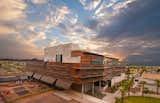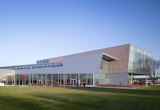Turin University Faculty Building (Foster + Partners: 2013)
Amid the sparkling new facades of these curved structures on the River Dora, the concept of a quad has been radically updated. While the steel-and-glass exterior calls to mind the forward-thinking seriousness of a tech company campus, the spacious green quad, rooftop canopies, and a “philosopher’s walk” make sure the renovation leaves space for old-fashioned contemplation.
Inspired by the color wheel, the interior design firm Silvola & Seppänen reimagined the art and design department of the University of Lapland to be spacious and open that features a spacious common area connecting all the activities from the art library to a virtual studio. This was achieved by dividing the space into four zones, each distinguished by a different color and function.
University of Oregon Hatfield-Dowlin Complex (ZGF Architects: 2013)
Architect Gene Sandoval and the rest of the design team created this futuristic athletic complex to create a structure centered around the players, not the fans. This new home for the Oregon Ducks football team incorporated the firm’s various disciplines to create a space scaled to football-player dimensions (note the larger entryways and hallways). The textured glass facade, detached from the building envelope, reduces glare inside, where players often spend hours studying film.
University Classroom Building; Duluth, Minnesota
Salmela Architect
Architect David Salmela relied on plant coverage to help maintain the strict standards of a German Passivhaus design system. Passivhaus, which utilizes a thick envelope created by insulated walls and roof and triple-glazed windows is a highly effective way to structure ultra-low energy systems. Salmela added a living roof, planted with butterfly-attracting vegetation, and surrounding tree covers to shade the building.
ASU Polytechnic Academic District; Mesa, Arizona
RSP Architects and Lake|Flato
The architect teams wanted to design ASU’s campus in a way that would reflect the surrounding desert climate. They maximized shade by grouping the new LEED gold buildings in dense clusters and creating courtyards and arcades to maximize airflow. The teams also removed 14 acres of asphalt and concrete sidewalk and replaced it with indigenous plants, which will help alleviate solar heat gain and reestablish the native habitat. ASU hopes that this will increase the amount of pedestrians and build a community around this former commuter campus.
1,245 more photos



































